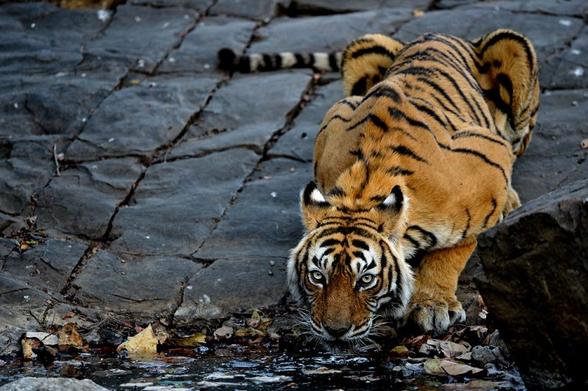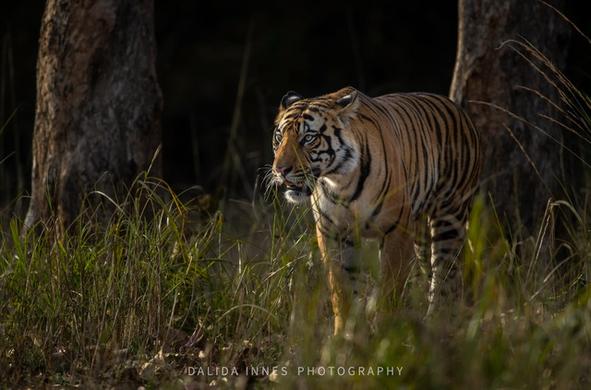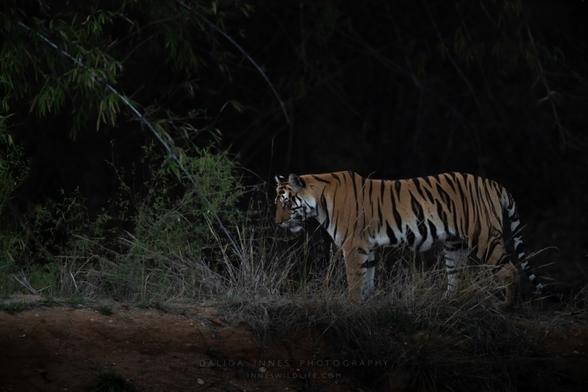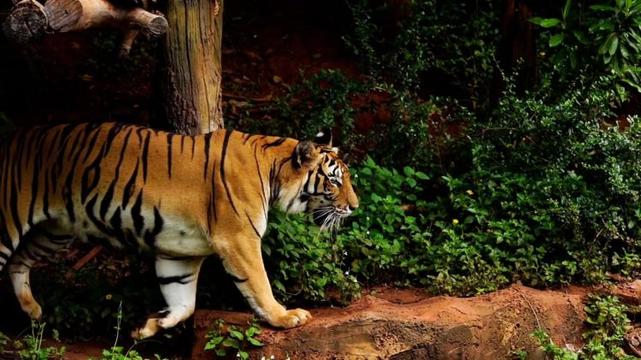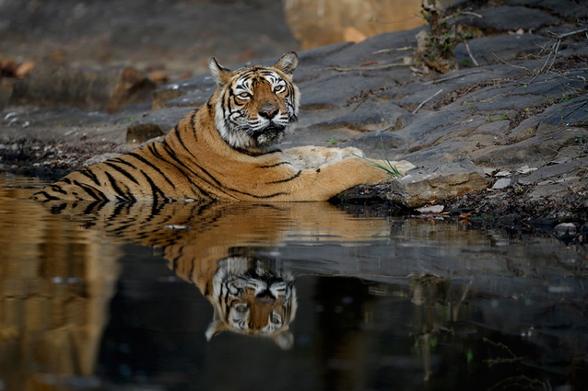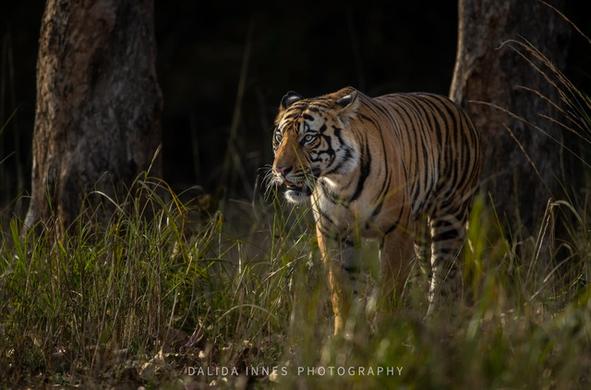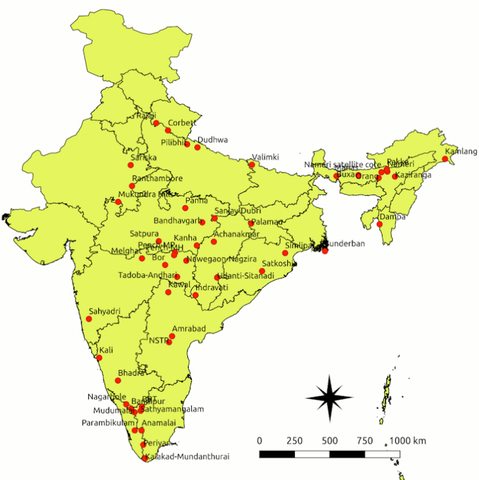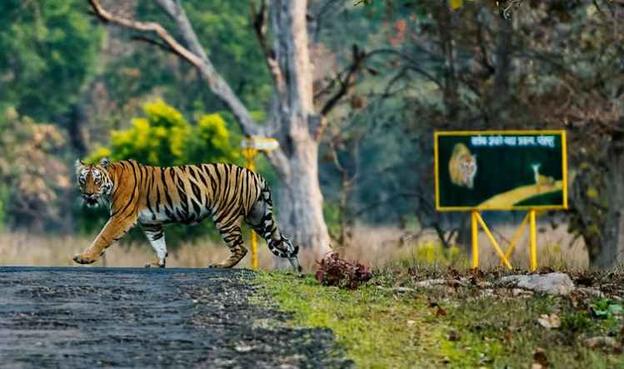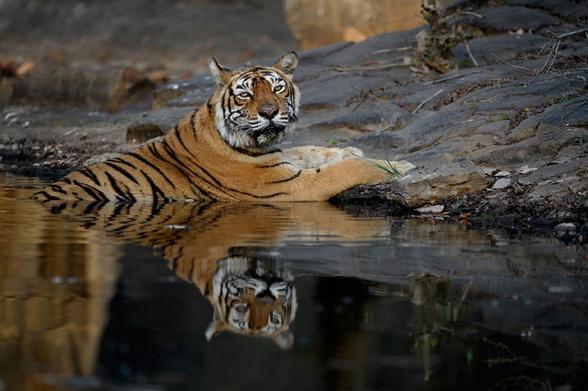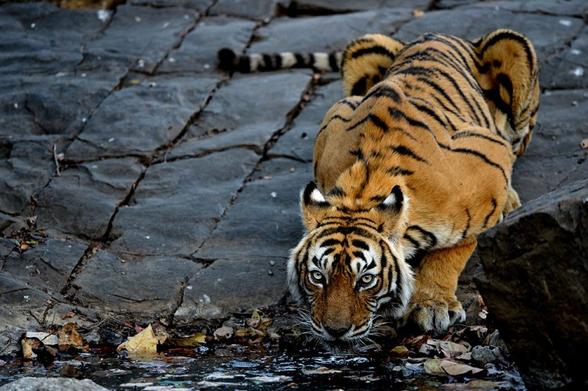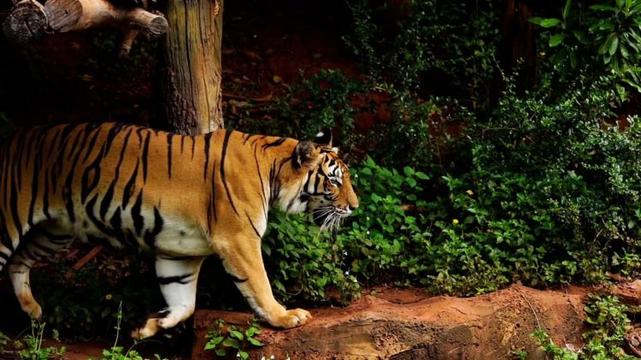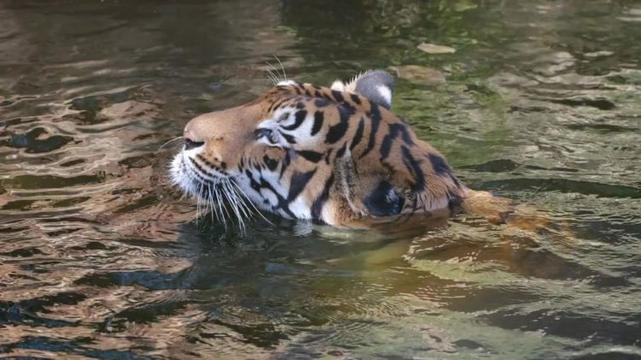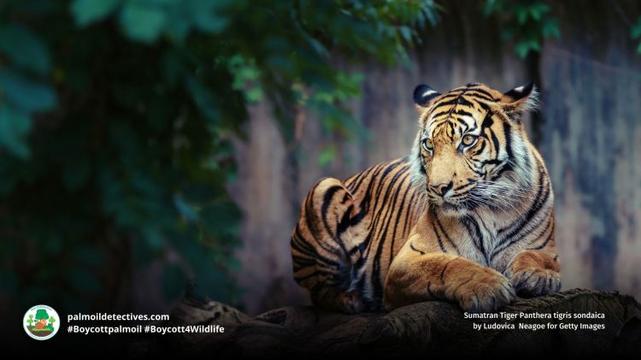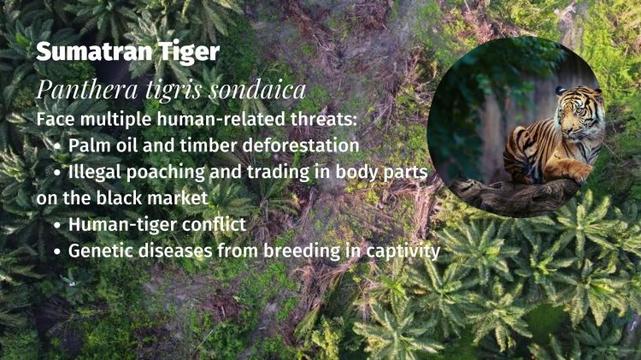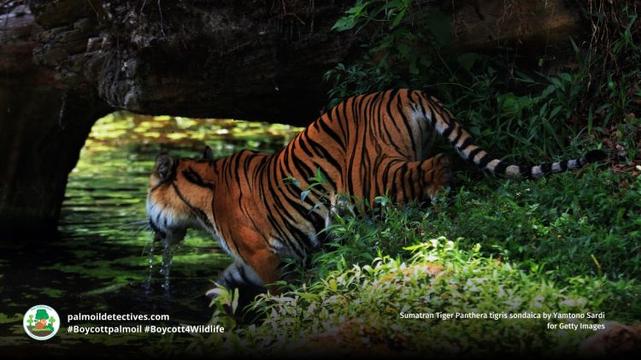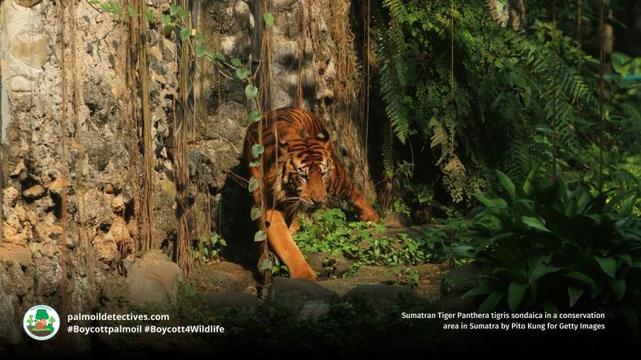Tiger Panthera tigris
Endangered
Population: Around 3,900
Extant (resident): India, Bangladesh, Bhutan, Nepal, Myanmar, Malaysia, Indonesia, Thailand, China, Russia
Tigers, primarily native to Asia’s tropical forests, have seen their habitats shrink dramatically over time. Notably, the Amur Tiger endures in Russia, and there have been sightings of these majestic creatures as high as 4,500 m in Bhutan. Tragically, fewer than 400 tigers remain in Indonesia, clinging to life in Sumatra’s dwindling forests. This decline is attributed to both rampant poaching and severe deforestation, especially for palm oil and pulp industries. As Asia continues to develop rapidly, the vast territories tigers need are shrinking, replaced by agriculture, commercial logging, and settlements. Moreover, tigers‘ prey faces threats from hunting and competition with domestic livestock. It’s time to act and use our wallet as a weapon: be #vegan #Boycottpalmoil #Boycott4Wildlife.
For 🇮🇩 Indonesia’s #tigers 🐅 fewer than 400 hang on to survival in rainforests of #Sumatra. Endangered by #poaching and #deforestation for #palmoil and timber. Boycott the brands sending them #extinct 😡🧐#Boycottpalmoil #Boycott4Wildlife @palmoildetect https://wp.me/pcFhgU-fT
Share to BlueSky Share to TwitterThe mighty and majestic #tiger 🐅🐯 of #Sumatra are on the brink of #extinction from #palmoil and #mining #deforestation. Less than 400 remain alive! 😭Use your wallet as a weapon and fight for them #Boycottpalmoil #Boycott4Wildlife 🌴🔥🚫 @palmoildetect https://wp.me/pcFhgU-fT
Share to BlueSky Share to TwitterTigers, the largest members of the cat family, are renowned for their majestic presence and striking orange coats with black stripes. They possess extraordinary strength and agility and maintain the balance of ecosystems as apex predators. With fewer than 4,500 remaining in the wild, tigers are classified as Endangered, facing grave threats from habitat destruction for palm oil, poaching, and human-wildlife conflict.
Their survival depends on urgent protection and animal advocacy. Protecting tigers ensures the preservation of the rich biodiversity within their habitats. Support their future by joining the #BoycottPalmOil and #Boycott4Wildlife movements.
Habitat
Tigers inhabit a wide variety of environments, including tropical rainforests, mangrove swamps, grasslands, and boreal forests. They require vast territories to hunt and breed, with males typically occupying larger ranges than females. Tigers are currently found in fragmented populations across Asia, with key strongholds in India, Sumatra, and Siberia.
These habitats are increasingly under threat due to deforestation, agricultural expansion, and infrastructure development, which have reduced their historical range by over 93%.
Diet
As apex predators, tigers primarily hunt large prey, such as sambar deer, wild boar, and buffalo. They are known for their stealth and strength, often ambushing their prey with a single powerful strike. Unlike other big cats, tigers can swim to catch prey, a unique skill that sets them apart.
In areas with reduced prey availability, tigers may hunt smaller mammals or livestock, which can lead to conflicts with humans.
Appearance and Behaviour
• Swimming Ability: Tigers are strong swimmers, often crossing rivers and lakes to hunt or cool off—an unusual trait among big cats.
• Individualised Stripes: Their stripes serve as camouflage and are unique to each tiger, making them distinguishable even in dense foliage.
• Vocal Range: Tigers have a wide vocal range, including growls, roars, and chuffs, used to communicate with other tigers.
• Apex Predator Status: As the top predator in their ecosystems, tigers help maintain balance by regulating prey populations.
Tigers are uniquely recognisable by their bold stripe patterns, which are as individual as fingerprints. Their muscular builds, powerful limbs, and retractable claws make them adept hunters and swimmers, setting them apart from most other big cats. Unlike lions or cheetahs, tigers are solitary by nature and fiercely territorial.
Their physical features include a robust skull, long canine teeth, and strong jaw muscles designed for gripping and tearing prey. Tigers are also among the few big cats that enjoy water, often cooling off in rivers and lakes. Their signature behaviours include scent marking, vocalisations such as roars and chuffs, and stealthy stalking of prey.
Reproduction & Mating
Tigers reach sexual maturity at around 3-4 years of age. Breeding typically occurs year-round, but more frequently during the winter months. After a gestation period of approximately 100 days, females give birth to 2-4 cubs in secluded dens.
Cubs are dependent on their mothers for the first 18 months, learning essential survival skills like hunting. Only about half of all cubs survive to adulthood, as they face threats from predators, disease, and starvation.
Threats
Habitat Destruction: Deforestation for palm oil agriculture, timber logging, and development fragments their habitats, isolating populations.
• Poaching: Tigers are hunted for their skins, bones, and other body parts, often sold illegally for traditional medicine or as luxury items. Organisations like EIA directly combat this illegal trade.
• Prey Depletion: Overhunting of herbivores reduces food availability, impacting tiger populations.
• Human-Wildlife Conflict: As human settlements expand, conflicts arise, often leading to retaliation killings of tigers.
The last of Indonesia’s tigers—now fewer than 400—are holding on for survival in the remaining patches of forests on the island of Sumatra. While poaching claims most tigers each year, deforestation remains a serious threat.
Sumatra has lost more than half of its forests in the last 40 years, primarily due to conversion for palm oil and pulp plantations. Poaching for illegal trade in high-value Tiger products including skins, bones, meat and tonics is a primary threat to Tigers.
Asia is a densely populated and rapidly developing region, bringing huge pressures to bear on the large wild areas required for viable Tiger populations. Conversion of forest land to agriculture and silviculture, commercial logging, and human settlement are the main drivers of Tiger habitat loss. With their substantial dietary requirements,
Tigers require a healthy large ungulate prey base, but these species are also under heavy human subsistence hunting pressure and competition from domestic livestock.
Tigers are classified as Endangered on the IUCN Red List, with fewer than 4,500 individuals remaining in the wild. While conservation efforts have stabilised some populations, habitat loss and poaching continue to pose significant challenges. Collaborative international efforts are crucial to ensuring their survival.
The last of Indonesia’s tigers—now fewer than 400—are holding on for survival in the remaining patches of forests on the island of Sumatra. While poaching claims most tigers each year, deforestation remains a serious threat.
IUCN RED LIST
Support Tiger Protection
• Boycotting palm oil and other products linked to deforestation.
• Contributing to organisations that protect tiger habitats and combat illegal poaching and animal trafficking like Traffic and EIA.
• Raise awareness about the critical importance of tigers in maintaining healthy ecosystems by joining the #BoycottPalmOil and #Boycott4Wildlife movement.
Further Information
Britannica. (2024). Tiger. Retrieved from https://www.britannica.com/animal/tiger
Goodrich, J., Wibisono, H., Miquelle, D., Lynam, A.J., Sanderson, E., Chapman, S., Gray, T.N.E., Chanchani, P. & Harihar, A. 2022. Panthera tigris. The IUCN Red List of Threatened Species 2022: e.T15955A214862019. https://dx.doi.org/10.2305/IUCN.UK.2022-1.RLTS.T15955A214862019.en. Accessed on 20 December 2024.
Panthera. (2024). Tiger. Retrieved from https://panthera.org/cat/tiger
Dalida Innes Wildlife Photography
How can I help the #Boycott4Wildlife?
Take Action in Five Ways
1. Join the #Boycott4Wildlife on social media and subscribe to stay in the loop: Share posts from this website to your own network on Twitter, Mastadon, Instagram, Facebook and Youtube using the hashtags #Boycottpalmoil #Boycott4Wildlife.
2. Contribute stories: Academics, conservationists, scientists, indigenous rights advocates and animal rights advocates working to expose the corruption of the palm oil industry or to save animals can contribute stories to the website.
Mel Lumby: Dedicated Devotee to Borneo’s Living Beings
Anthropologist and Author Dr Sophie Chao
Health Physician Dr Evan Allen
The World’s Most Loved Cup: A Social, Ethical & Environmental History of Coffee by Aviary Doert
How do we stop the world’s ecosystems from going into a death spiral? A #SteadyState Economy
3. Supermarket sleuthing: Next time you’re in the supermarket, take photos of products containing palm oil. Share these to social media along with the hashtags to call out the greenwashing and ecocide of the brands who use palm oil. You can also take photos of palm oil free products and congratulate brands when they go palm oil free.
https://twitter.com/CuriousApe4/status/1526136783557529600?s=20
https://twitter.com/PhillDixon1/status/1749010345555788144?s=20
https://twitter.com/mugabe139/status/1678027567977078784?s=20
4. Take to the streets: Get in touch with Palm Oil Detectives to find out more.
5. Donate: Make a one-off or monthly donation to Palm Oil Detectives as a way of saying thank you and to help pay for ongoing running costs of the website and social media campaigns. Donate here
Pledge your support#bigCat #Borneo #Boycott4wildlife #BoycottPalmOil #carnivores #deforestation #EndangeredSpecies #extinct #extinction #feline #Malaysia #mining #palmoil #poaching #predator #predators #SouthEastAsia #Sumatra #tiger #TigerPantheraTigris #tigers #vegan #wildcat
